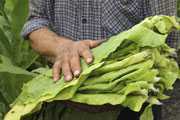Green Tobacco Sickness

Overview
Green tobacco sickness (GTS) is a type of nicotine poisoning that occurs while handling tobacco plants. Workers are at especially high risk for developing this illness when their clothing becomes saturated from tobacco that is wet from rain or morning dew, or perspiration. Symptoms of GTS include nausea, vomiting, dizziness, and headaches. Workers have also noted difficulty sleeping or eating. Symptoms of GTS may be similar to those of heat illness and pesticide poisoning, which can make it difficult to diagnose. This topic page provides references to resources intended to help employers, workers, and health professionals identify and reduce risks for job-related green tobacco sickness.
NIOSH Publications
NIOSH and OSHA release
Recommended Practice: Green Tobacco Sickness
DHHS (NIOSH) Publication Number 2015-104
Reducing the Impact of Green tobacco Sickness among Latino Farmworkers
DHHS (NIOSH) Publication Number 2011-111
Green tobacco sickness in tobacco harvesters-Kentucky, 1992
MMWR Morb Mortal Wkly Rep. 1992 Apr 9;42(13):237–240.
Educational Materials
Wake Forest University School of Medicine—winner of the 2006 NORA Innovative Research Award for its GTS project , Reducing the Impact of Green Tobacco Sickness among Latino Farmworkers—produced educational materials for farmworkers that translated research results into media formats culturally and educationally appropriate for workers.
Learning about Green Tobacco Sickness: Juan's Experience
This black and white fotonovela serves as a teaching tool for farmworkers about exposure, prevention, and treatment of green tobacco sickness.
El Terror Invisible
One segment of this Spanish-language video (with English subtitles), Mean Green and Other Risks, presents information on the symptoms, causes, treatment, and prevention of green tobacco sickness.
Journal Articles
Green tobacco sickness in children and adolescents
Public Health Rep. 2005 Nov-Dec;120(6):602–605
Nicotine exposure and decontamination on tobacco harvesters' hands
Am. Occup. Hyg. 2005 49(5):407–413
Cotinine levels and green tobacco sickness among shade-tobacco workers
J Agrmedicine 2005 10(2):27–37
High Levels of transdermal nicotine exposure produce green tobacco sickness in Latino farmworkers
Nicotine Tob Res. 2003 Jun;5(3):315–321
Farmer health beliefs about an occupational illness that affects farmworkers: the case of green tobacco sickness
J Agric Saf Health 2003 Feb;9(1):33–45
Detecting patterns of occupational illness clustering with alternating logistic regressions applied to longitudinal data
Am J Epidemiol. 2003 Sep 1;158(5):495–501
Hispanic farmworker interpretations of green tobacco sickness
J Rural Health, Fall 2002;18(4):503–511
Predictors of incidence and prevalence of green tobacco sickness among Latino farmworkers in North Carolina, USA
J Epidemiol Community Health 2001 55:818–824
The incidence of green tobacco sickness among Latino farmworkers
J Occup Environ Med, 2001 43(7):601–609
Environmental and behavioral predictors of salivary cotinine in Latino tobacco workers
J Occup Environ Med, 2001 43:844–852
Migrant farmworkers and green tobacco sickness: New issues for an understudied disease
Am J Ind Med. 2000 Mar;37(3):307–315
Spatial and temporal clustering of an occupational poisoning: The example of green tobacco sickness
Stat Med. 1996 Apr 15-May 15;15(7-9):747–757
Familial clusters of green tobacco sickness
J Agromedicine 1996 3(2):51–59
Green tobacco sickness: Occupational nicotine poisoning in tobacco workers
Arch Environ Health 1995 Sep-Oct;50(5):384–389
- Page last reviewed: September 18, 2014
- Page last updated: March 30, 2015
- Content source:
- National Institute for Occupational Safety and Health Education and Information Division


 ShareCompartir
ShareCompartir